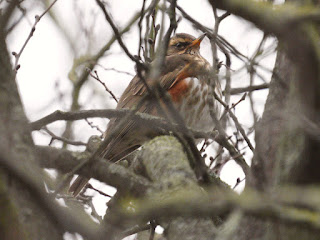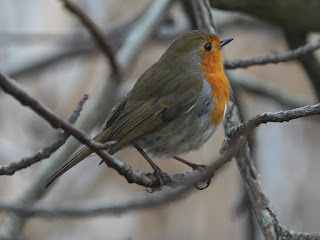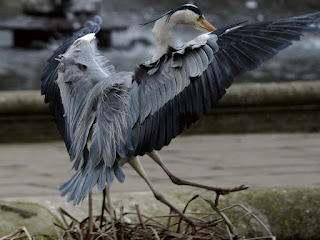Great Tits are usually said to have a repetitive two-note song that sounds like 'Tea-cher, tea-cher.' In fact their songs are quite varied and may have any number of notes from one to eleven. They are the signatures of individual birds. If you hear a songbird and can't guess what it is, it's likely to be a Great Tit.
The expanse of mud left by the funfair is mostly populated by Starlings and Carrion Crows looking for insects and worms, which survive being covered up for several months.
There was also a small flock of Goldfinches in the treetops ...
... and just one Redwing, maybe the one I saw yesterday.
However, David Jeffreys saw more Redwings on Buck Hill, and probably the rest of the flock are waiting for the site to quieten down before they come over. The last Portakabins were being taken away today.
There were also some Pied Wagtails hunting on the mud, not close enough for a picture. But I found a Grey Wagtail running along the edge of the Serpentine. It found a tiny white larva.
At the Diana fountain landing stage a pair of Robins landed in the sweetgum tree before chasing one another in the reed bed.
A Lesser Black-Backed Gull at the Lido was in a bad mood, calling and harassing the larger Herring Gulls.
This isn't the pigeon-eating gull. But he had clearly been at work, as a couple of Carrion Crows were finishing off the remains of his breakfast.
A Black-Headed Gull had to retreat hastily when it was chased by two Coots trying to snatch a bit of bread from it.
It was the day of the monthly bird count, and the Common Gull population was at its winter peak of 55, most of them as usual on the Round Pond. Each winter they arrive late and gradually, and leave before spring. Here are five on the buoys at the Lido.
A picture showing the relative sizes of a Herring Gull, a Black-Headed Gull and a Common Gull.
A Grey Heron landed in a planter in the Italian Garden.
A pair of Great Crested Grebes displayed on the Serpentine.
A Moorhen shook out its feathers on a post.











A vernacular name for the Great Tit in Extremadura is "chichipán", on account of its three-note call, chi-chi-pan, chi-chi-pan (don't look at me, that's what country folks heard).
ReplyDeleteThose Coots look menacing and determined. Poor Gull is too small to withstand their concerted assault.
On Sunday afternoon I saw a dozen or so Redwing foraging beside the path from Physical Energy to Bayswater Road Inverness Terrace exit. They were very wary – when I stopped to look, they took to the branches. This contrasts with their behaviour in exactly the same place last year when they were hoovering along with a flock of starlings and disregarded me. Did they take courage from their fearless companions, I wondered.
DeleteThat three-note call is one of their commonest, so it's an appropriate name.
DeleteI've occasionally got quite close to Redwings by going past them on a path and pretending not to notice them, or by standing still and waiting until they approached.
Delete